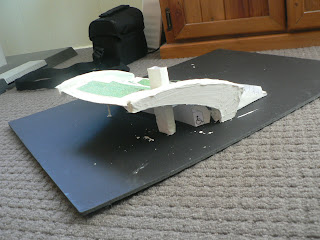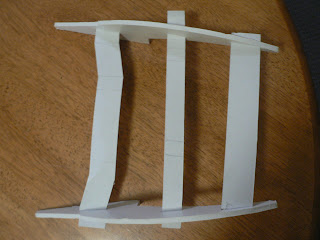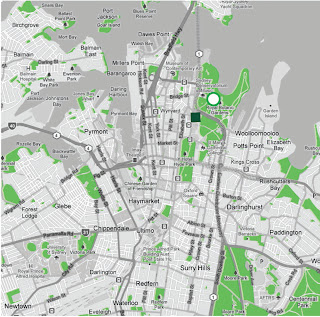Friday, 11 November 2011
Monday, 7 November 2011
LOGO - THE PARLIAMENT STEPS
I have started working on a logo to help communicate my design idea clearly during the presentation. After tossing up between a few different names, I have decided to call my project THE PARLIAMENT STEPS.
The colour green lends itself to this project so I will keep the logo very simple and use a bold green which I can incorporate into my panels also. After a few attempts at the logo, the one I am happiest with is the following:
The logo will have 2 different forms. The predominantly green one I will use to introduce the project and the other I will use as a watermark on the rest of the panels.
Friday, 4 November 2011
ROOF STRUCTURE
Originally I wanted to create a space with as authentic an outdoor feel as possible, so the idea of a roof doesn't overly appeal to me. However in the Brisbane climate shade cover will be an important issue, otherwise the steps will no doubt be under utilised during the middle of the day and afternoon when the sun is at its hottest.
I am visioning the steps being utilised as a meeting place and a social place during the day, during office lunch breaks for some and breaks from exercise routines for others. For this reason then it is important that I incorporate a shading roof cover.
As I still want an open air feel to retain the outdoor quality of the space I will propose a roof cover which is as open as possible and does not cover the whole structure. I believe it will provide protection from the sun without feeling enclosed or separated from the surrounding natural environment. I am proposing timber battons, supported by steel columns, and in the shape of a palm leaf, a tree that is found throughout the whole of the botanic gardens. The steel will be minimal and the timber will be the dominant material, sensitive to the surrounding environment in the gardens. It has a warm feel and ties in with the timber of the rotunda structure located between the stirs and the Albert St entrance.
I experimented with some timber pieces to determine the feel I could get from different shapes in the timber before deciding on the final form for the roof (see final panels for drawings).
Thursday, 3 November 2011
DEVELOPMENT AND MODEL
My design is getting to a stage now where I am ready to start documenting. There are still some details I am unsure about. They are mainly issues to do with structure and also related to integrating services into the stair.
STRUCTURE:
To support the cantilever structure, I have assumed a deep system foundation that extends from the foot of the steps to the back of the storage room underneath the steps. This should allow a secure base to fix the structure down into the earth. Two large columns form the frame of the cantilever and extend down alongside the steps and into the foundations also. These columns would be post tensioned concrete.
It is assumed that the steps could be cast in modules in a lock and key fashion so as to hold fast in place and supported with steel beams. The concrete modules would also be post tensioned concrete and be cast with the necessary conduits to allow the integration of services.
SERVICES:
- The facility would require electricity and hydraulic services as well as the following services integrated into the construction:
- Conduit for LED lighting strips to run along the underside of the concrete seating steps to light the 'aisles'.
- Drainage from the lowest point in the grass bed concrete stair modules down to the base of the structure.
- Mechanical services to rise and lower the grid panel for reconfiguration of space.
The model I made allowed me to resolve the remaining space and circulation issues:
Wednesday, 26 October 2011
DEVELOPMENT
Now that I have made a decision on my design concept and function, the development is travelling relatively quickly. I have a good idea of how I would like the space to work but I am getting stuck on the structure and also on choosing a site. I wanted to locate the design in the Queen Victoria Park in the centre of the city due to its central location and vicinity to the constant action and activity of the city. I never noticed before that there is a giant carpark beneath this park. And as I have also been looking at the structure of the staircase and would like to create a cantilever structure, this will not work. I'm not sure structurally what the cantilever would require but I think the design I am working on would be best cast in concrete and post tensioned and would also require some sort of deep foundation system to counteract the moment created by the cantilever.
I have started a model to test out the overall shape and aesthetic which I would like to achieve in the design. I also uses it to test a variety of seating angles. It worked very effectively. I very quickly got an idea of how the different seating would affect the overall look and feel of the design which made the design very easy to make.
ACCESSIBILITY
It is important to me that the proposed space never closes. A parliament for the people should offer qa space which is always accessible and available. This will be possible for me to do as I would like to integrate it as part of the park, so that when it is not being used for a specific function, it is merely a part of the park for people to enjoy. It is also an important consideration to design a space which can be accessed by persons with disabilities also.
Sunday, 16 October 2011
SITES
To effectively distribute this design across Australia I am proposing that each of the Capital cities host a Parliament stair. Upon looking at each of these cities and the planning it was relatively simple to pinpoint and suggest appropriate sites that met the following requirements:
- Located in the central activity hub of the city
- Located close to the parliament house of the city
- Located in an areas of public parkland/ green space with enough space to create sufficient circulation routes to from, and around the stair
The locations I am proposing for each of the cities are:
(The existing parliament house is shown as a dark square. The proposed parliament stair is shown as a green circle)
For this project, I will develop the Brisbane site further to work out the issues with access and circulation.The selected site in Brisbane is in the place of a current rose garden in the Brisbane Botanic Gardens. The main reasons I chose this site to house the Brisbane parliament stairs are:
- It is central in the CBD yet sheltered enough that traffic noise will not be an issue
- there is plenty of space to develop on this site.
- It is on the axis connecting public places in the city. This is significant as this design proposal is about creating a space FOR the people.
- There is excellent access to the site by all persons. It is accessed through one of the main entrances to the Botanical gardens, off Albert St. The circulation paths are wide and suitable for persons with a wheelchair also. There are no steep inclines to get to the site from the entrance. It is easily located and will be visible from Albert St.
- The existing rose garden is continually being replanted so it is proposed that this cycle of planting simply be relocated to another area in the gardens to retain the display of roses in the gardens.
These ebimap image shows the area along with the existing circulation routes clearly:
The photos show the condition of the site and the neighboring garden beds with flat grass:
Thursday, 13 October 2011
DESIGN CONCEPT
The tutorial session on Friday was a very quick consultation but a very useful one. Cameron gave me 2 different directions to look into further which I have done and I am starting to get a clearer idea about my proposed solution.
Cameron suggested I look into an example of architecture that could be relevant to my investigations into landscaping seating and building in underneath. The example is an architecture that came about from the result of a competition for the redesign of the discount ticket booth for TKTS in New York.
TKTS
Completed: 2008
Designers: Perkins Eastman, Choi Ropiha, PKSB Architects
Function:
Cameron also gave me a further insight into my ideas about utilising parks, reminding me that the city Canberra was originally designed to follow the city beautiful movement which strived to create the ideals of a garden city. This has led me to revisit the planning of Canberra as a city designed for the parliament and to look closer at the way the ideals of the garden city have been incorporated into the planning.
Completed: 2008
Designers: Perkins Eastman, Choi Ropiha, PKSB Architects
Function:
- new structure to provide purpose for their concession lease.
- Father Duffy who were interested in restoring Duffy’s presence.
- Gathering point Times Square’s economic and branding improvements
Images taken from http://www.dezeen.com
Cameron also gave me a further insight into my ideas about utilising parks, reminding me that the city Canberra was originally designed to follow the city beautiful movement which strived to create the ideals of a garden city. This has led me to revisit the planning of Canberra as a city designed for the parliament and to look closer at the way the ideals of the garden city have been incorporated into the planning.
This included looking at the green roof form of the parliament house, and this, together with the exploration into tiered seating or stairs have finally led me to my design concept.
I will take inspiration from the existing parliament house architecture and create a new space but one that is linked to the existing house. After all, I am not proposing a solution which aims to replace the existing Parliament house, but rather an extension which aims to bring the parliament to the people. I will take the green roof form as used in the existing parliament house and follow this form to create a giant staircase of sorts. This staircase will be integrated into the natural context of the park and have the ability to be used for the seating for an outdoor theatre/lecture space. I will then use the space underneath the staircase to design a space that can contribute to housing other parlimentary functions that are related to the people.
Thursday, 22 September 2011
ENGAGING SPACES
I have been looking at ideas and ways to design space within parks to engage people. Playgrounds is an obvious one for children, but I am also finding other examples that invite people.. The examples I found for spaces which successfully invite peoples attention all had something in common. There was an interesting element about these spaces, each of these parks or spaces created an experience out of the ordinary, changing the everyday context that the environment might otherwise be experienced in. This promise of a different experience is drawing people to the place and appealing to them to interact with the space. Some examples of successful spaces involve an unexpected scale, others unexpected forms. In the example shown in the lecture, the New York Highline park, the ordinary context is changed.. the park exists on an old railway. It is risen above the city and the park is enjoyed from a very different perspective than ordinary.
Subscribe to:
Comments (Atom)












































